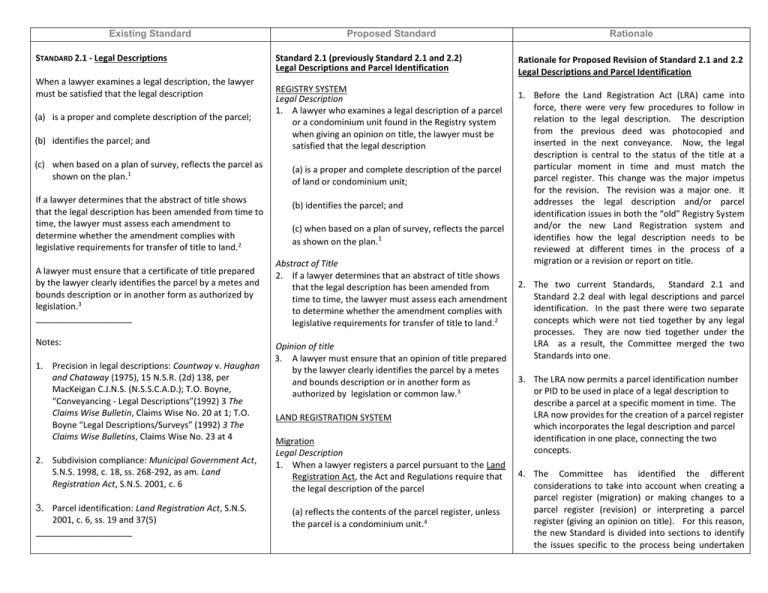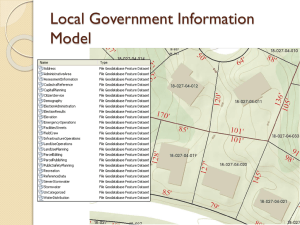Real Estate Standard 2.1 - Lawyer's Insurance Association of Nova
advertisement

Existing Standard STANDARD 2.1 - Legal Descriptions When a lawyer examines a legal description, the lawyer must be satisfied that the legal description (a) is a proper and complete description of the parcel; (b) identifies the parcel; and (c) when based on a plan of survey, reflects the parcel as shown on the plan.1 If a lawyer determines that the abstract of title shows that the legal description has been amended from time to time, the lawyer must assess each amendment to determine whether the amendment complies with legislative requirements for transfer of title to land.2 A lawyer must ensure that a certificate of title prepared by the lawyer clearly identifies the parcel by a metes and bounds description or in another form as authorized by legislation.3 ____________________ Notes: 1. Precision in legal descriptions: Countway v. Haughan and Chataway (1975), 15 N.S.R. (2d) 138, per MacKeigan C.J.N.S. (N.S.S.C.A.D.); T.O. Boyne, “Conveyancing - Legal Descriptions”(1992) 3 The Claims Wise Bulletin, Claims Wise No. 20 at 1; T.O. Boyne “Legal Descriptions/Surveys” (1992) 3 The Claims Wise Bulletins, Claims Wise No. 23 at 4 2. Subdivision compliance: Municipal Government Act, S.N.S. 1998, c. 18, ss. 268-292, as am. Land Registration Act, S.N.S. 2001, c. 6 3. Parcel identification: Land Registration Act, S.N.S. 2001, c. 6, ss. 19 and 37(5) ____________________ Proposed Standard Standard 2.1 (previously Standard 2.1 and 2.2) Legal Descriptions and Parcel Identification REGISTRY SYSTEM Legal Description 1. A lawyer who examines a legal description of a parcel or a condominium unit found in the Registry system when giving an opinion on title, the lawyer must be satisfied that the legal description (a) is a proper and complete description of the parcel of land or condominium unit; (b) identifies the parcel; and (c) when based on a plan of survey, reflects the parcel as shown on the plan.1 Abstract of Title 2. If a lawyer determines that an abstract of title shows that the legal description has been amended from time to time, the lawyer must assess each amendment to determine whether the amendment complies with legislative requirements for transfer of title to land.2 Opinion of title 3. A lawyer must ensure that an opinion of title prepared by the lawyer clearly identifies the parcel by a metes and bounds description or in another form as authorized by legislation or common law.3 LAND REGISTRATION SYSTEM Rationale Rationale for Proposed Revision of Standard 2.1 and 2.2 Legal Descriptions and Parcel Identification 1. Before the Land Registration Act (LRA) came into force, there were very few procedures to follow in relation to the legal description. The description from the previous deed was photocopied and inserted in the next conveyance. Now, the legal description is central to the status of the title at a particular moment in time and must match the parcel register. This change was the major impetus for the revision. The revision was a major one. It addresses the legal description and/or parcel identification issues in both the “old” Registry System and/or the new Land Registration system and identifies how the legal description needs to be reviewed at different times in the process of a migration or a revision or report on title. 2. The two current Standards, Standard 2.1 and Standard 2.2 deal with legal descriptions and parcel identification. In the past there were two separate concepts which were not tied together by any legal processes. They are now tied together under the LRA as a result, the Committee merged the two Standards into one. 3. The LRA now permits a parcel identification number or PID to be used in place of a legal description to describe a parcel at a specific moment in time. The LRA now provides for the creation of a parcel register which incorporates the legal description and parcel identification in one place, connecting the two concepts. Migration Legal Description 1. When a lawyer registers a parcel pursuant to the Land Registration Act, the Act and Regulations require that 4. 4. The Committee has identified the different considerations to take into account when creating a the legal description of the parcel parcel register (migration) or making changes to a parcel register (revision) or interpreting a parcel (a) reflects the contents of the parcel register, unless 4 register (giving an opinion on title). For this reason, the parcel is a condominium unit. the new Standard is divided into sections to identify the issues specific to the process being undertaken Additional Resource: PID may remain the same after the extent is altered C. Walker, Q.C., “Abstracts and the Land Registration System” in Land Registration Act Education Program, LRA Education Material STANDARD 2.2 – Parcel Identification Before the Land Registration Act comes into force in a registration district, a lawyer preparing an opinion of title or preparing an instrument affecting title to a parcel in the registration district, should (a) examine the information relating to the parcel found on Property Online; and (b) annotate on the legal description of each parcel its apparent Property Identification Number (PID) and Assessment Account Number (AAN), to further the integrity of the information contained in Property Online. (b) where a short form description has been approved, accurately reflects the information contained in the plan on which the short form description is based;5 (c) accurately reflects the information contained in the description in the Declaration on file with the Registrar of Condominiums when the parcel is a condominium unit;6 Errors in Property On Line 2. At the time of migration, the Regulations under the Land Registration Act require a lawyer who identifies errors in the Property Online mapping to bring the information to the attention of Property Online.7 Historical Information 3. A lawyer must give consideration to retaining historical information in the parcel description to assist with interpretation of the parcel register. 8 Registration and Recording Legal Description 1. When a lawyer registers or records a document in the parcel register pursuant to the Land Registration Act, the Act and Regulations require that the legal description of the parcel: The annotation should be clearly worded to show that it is not an operative part of the instrument and that it is given as reference information only. (a) reflects the contents of the parcel register in the form of full text, short form legal description or PID, unless the parcel is a condominium unit;9 A lawyer identifying any apparent or possible errors in the Property Online mapping should bring the information to the attention of Property Online to further improve the accuracy of parcel mapping and integrity of parcel information. ____________________ (b) where a short form description has been approved, accurately reflects the information contained in the plan on which the short form description is based;10 Note: 1. "Property Online" means the internet-delivered application that provides subscribers with web (c) where the parcel is a condominium unit, the description accurately reflects the information contained in the description in the Declaration on file with the Registrar of Condominiums;11 by the lawyer under the LRA. based access to the Nova Scotia land registration information system. ____________________ Additional Resource: Reasonable steps be taken by Errors in Property On Line 2. At the time of revision, the Regulations under the Land Registration Act require a lawyer who identifies errors in the Property Online mapping to, bring the information to the attention of Property Online.12 Historical Information 3. A lawyer must give consideration to retaining historical information in the parcel description to assist with interpretation of the parcel register, and particularly when adding an easement benefit or burden to the parcel register during a revision. 13 _______________________ Notes: Precision in legal descriptions: Countway v. Haughn and Chataway(1975), 15 N.S.R.(2d) 138 , per MacKeigan C.J.N.S. (N.S.S.C.A.D.), T.O. Boyne, "Conveyancing - Legal Descriptions" (1992) 3 The Claims Wise Bulletin, Claims Wise No. 20 at 1; T.O. Boyne "Legal Descriptions/Surveys"(1992) 3 The Claims Wise Bulletins, Claims Wise No. 23 at 4; 2 Subdivision compliance: Municipal Government Act, S.N.S. 1998, c. 18, ss. 268-292, as am., Land Registration Act, S.N.S. 2001, c. 6 ; 3 See footnote 1; 4 Land Registration Act, s. 19, Reg 5(8), Reg 7(10), 7(11); 5 Regulation 2(1) definition of short form legal description, Regulation 5(8) and 7(10)(a)(ii). See also 7(12) and 7(13); 6 Regulation 7(11)(b); 7 Regulation 7(7)(c), 7(8); 8 Regulation 7(10A)*, Registrar General’s Communique Sept 2006, Land Registry Resource Materials- PDCA standards checklist; Gordon, Garth, Access and Red Flag Issues Under the LRA http://lians.ca/documents/AccessRedFlag.pdf; 9 Land Registration Act, ss. 19, 37(A)(1)(e), 47(3), 47(9), Reg 2(1) definition of short form legal description, 5(8), 7(2), 7(10), 7(11), 14(4) 15(2), and 16(2)(b); 10 Reg 2(1) definition of short form legal description, Reg 5(8), Reg 7(10)(a)(ii); 11 Reg 7(8), 7(11)(b); 12 See Footnote 4; 13 Regulation 7(7)(C), 7(10A) Registrar General’s Communique Sept 2006, Land Registry Resource Materials- PDCA standards checklist; Gordon, Garth, Access and Red Flag Issues Under the LRA http://lians.ca/documents/AccessRedFlag.pdf _______________________ Additional Resources: *C. Walker, Q.C., “Abstracts and the Land Registration System”; http://lians.ca/documents/AbstractsAndTheLand RegistrationSystem.pdf *Where’s the line: Surveyors, Lawyers and the Land Registration Act: http://lians.ca/documents/WheresThe Line.pdf http://lians.ca/documents/DiscussionPaper _______________________ Practice Notes *Regulation 7(7) states that (except for condominiums) the PDCA submitter must assist the parcel owner (or authorizing person) in identifying the parcel’s PID and take reasonable steps to identify the parcel. *Note that a PID for a parcel which has been subdivided may remain the same PID number after the extent of the parcel is altered by the subdivision. Caution should be exercised when the extent is altered, especially in regard to easements. The extent of an easement at the time the easement is created is not altered even though the extent of the parcel which has been assigned the same PID has changed. *The parcel description should match the parcel register whether the description is long form or short form. All benefits and burdens should be described in the parcel description unless the property is a condominium unit. *Consider using the long form description when the plan on which the short form description was based contains less information than the long form description.






